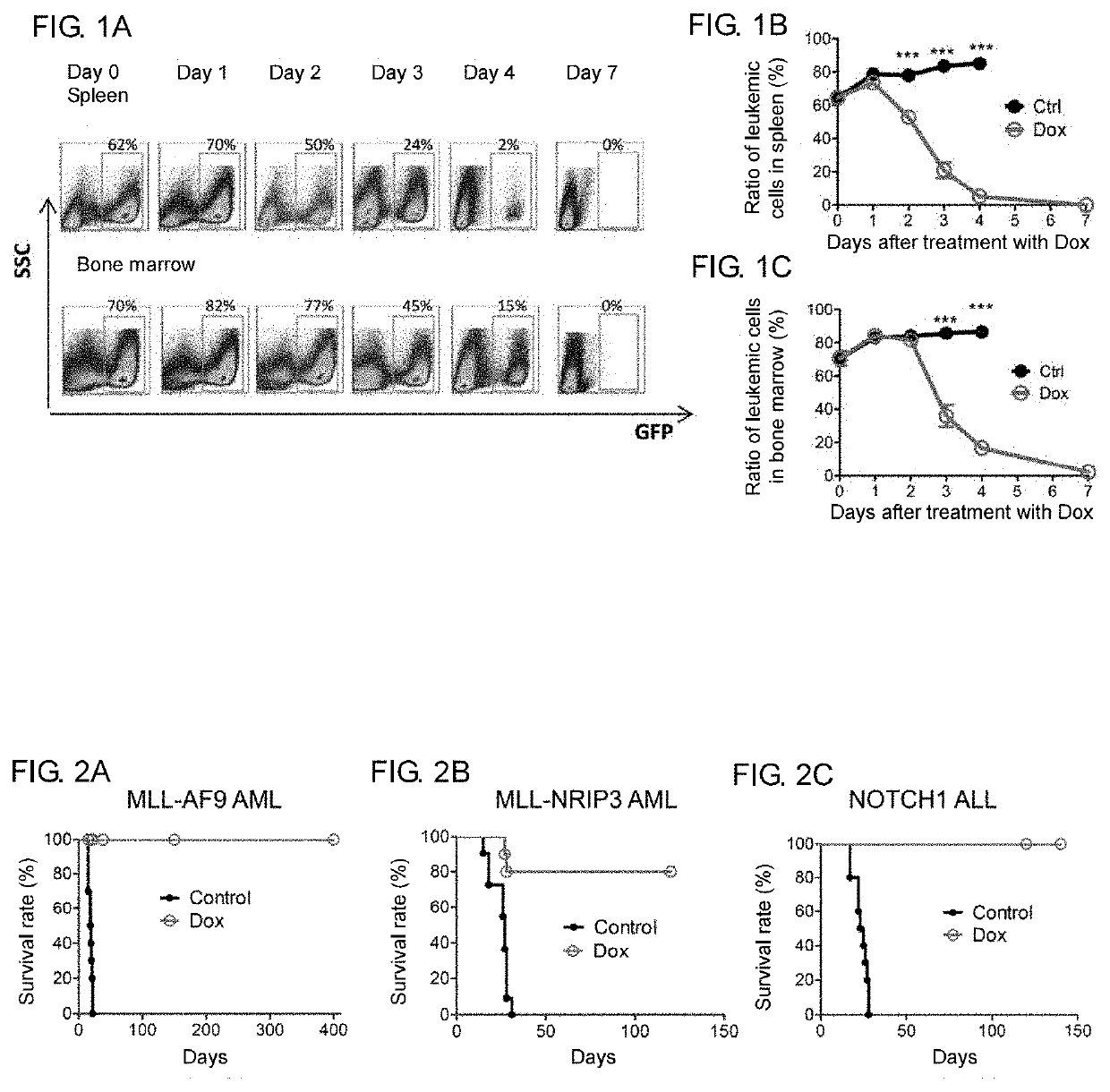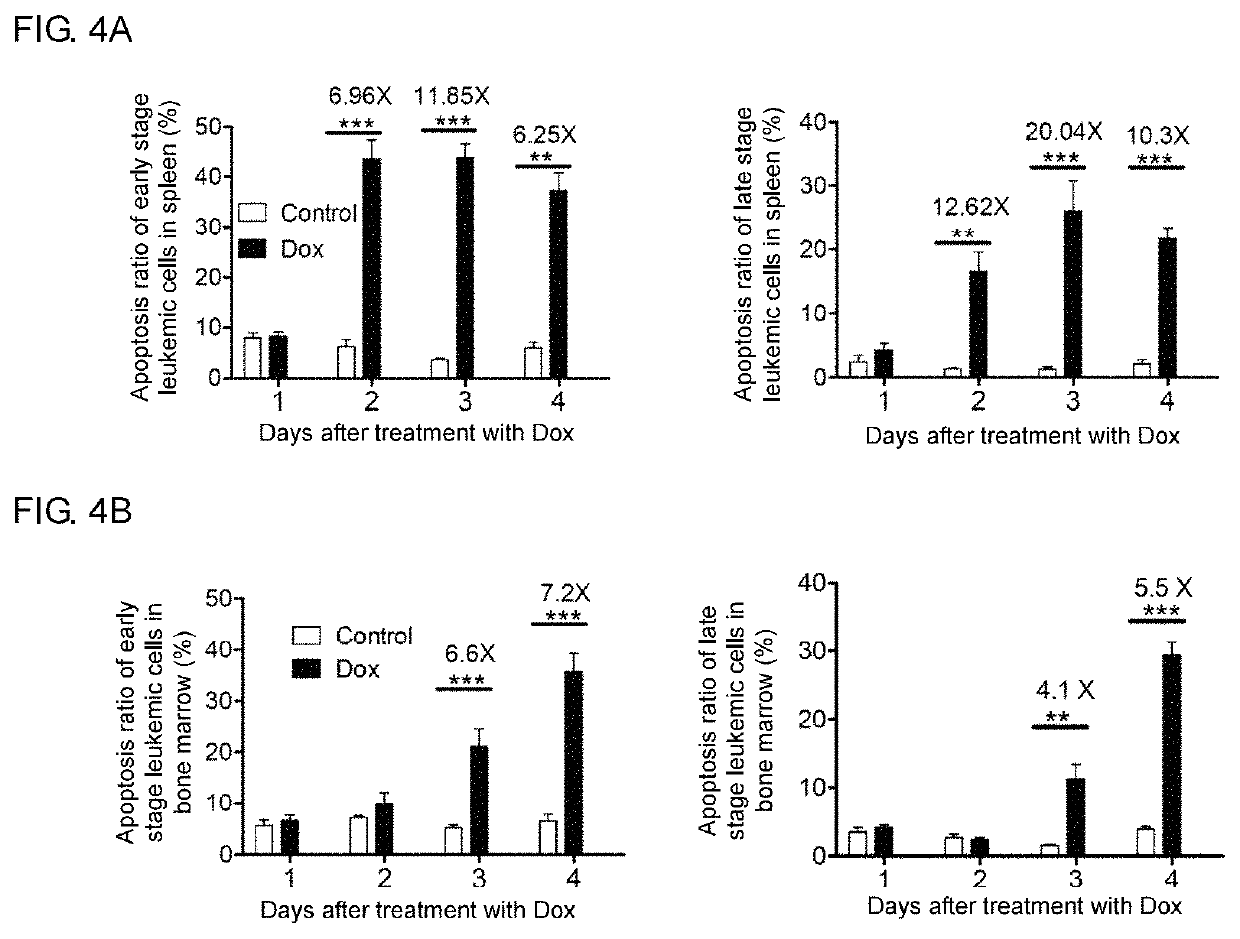Method of treating leukemia utilizing somatic cell reprogramming
a cell reprogramming and leukemia technology, applied in the field of methods, can solve the problems of low inducible efficiency, no genetic material involved in the method at all, and uncertain technical difficulty, and achieve the effects of promoting and promoting the initiation of the reprogramming process of leukemia cells
- Summary
- Abstract
- Description
- Claims
- Application Information
AI Technical Summary
Benefits of technology
Problems solved by technology
Method used
Image
Examples
embodiment 1
Utilizing Reprogramming Factor to Eliminate Mouse Leukemic Cells In-Vivo / In-Vitro
[0036]1. Preparation of leukemia retrovirus: method with lipofectamine2000 was used in preparation of retrovirus. 293T cells were cultured in 10 cm culture dish, when the cells reached a confluency of 90%, plasmids and lipofectamine2000 mixture were added. The plasmids include: packaging plasmids (pKat and pVSVG) and target plasmid of retrovirus (MSCV-MLL / AF9-IRES-GFP). Viral supernatants were collected at 48-hour and 72-hour respectively. Amicon Ultra-15 centrifugal filter devices (100K NMWL) was used for concentration.
[0037]2. Preparation of mouse acute myeloid leukemic cells: bone marrow cells were obtained from OSKM mice (or known as ‘all-iPS’ mice, the mice were developed by Professor Shaorong Gao's Laboratory, article source: Kang, L. et al. Cell Stem Cell. 2009;5:135-138.) and lineage-negative (Lin−) bone marrow cells were enriched by method using magnetic beads. Retrovirus carrying MLL-AF9 fusio...
embodiment 2
Utilization of Small Reprogramming Molecules to Induce the Elimination of Human Leukemic Cells In-Vitro
[0048]1. Human leukemic cell lines: a variety of leukemic cell lines were treated with the small reprogramming molecules and their apoptosis levels and growth condition were determined.
[0049]Treatment conditions: the initial cell number was 1×105.
[0050]HL-60, K562, NB4, Kasumi-1 and Jurkat cells: RPMI 1640+10% fetal bovine serum
[0051]THP-1 cells: RPMI 1640+10% fetal bovine serum+0.05 mM 2-mercaptoethanol
[0052]KG-1 and KG-1a cells: IMDM+20% fetal bovine serum
[0053]Concentration of small reprogramming molecules: forskolin (10 μM), VPA (500 μM), CHIR99021 (10 μM), RepSox (5 μM), tranylcypromine (5 μM) and TTNPB (1 μM)
[0054]The results are as shown in FIGS. 7A and 7B, in which after treated with combination of small reprogramming molecules FVC6TN, apoptosis was increased in all the leukemic cell lines and cell growth was severely suppressed.
[0055]2. Specimen of leukemia patients: total...
PUM
| Property | Measurement | Unit |
|---|---|---|
| concentration | aaaaa | aaaaa |
| concentration | aaaaa | aaaaa |
| Concentration | aaaaa | aaaaa |
Abstract
Description
Claims
Application Information
 Login to View More
Login to View More - R&D
- Intellectual Property
- Life Sciences
- Materials
- Tech Scout
- Unparalleled Data Quality
- Higher Quality Content
- 60% Fewer Hallucinations
Browse by: Latest US Patents, China's latest patents, Technical Efficacy Thesaurus, Application Domain, Technology Topic, Popular Technical Reports.
© 2025 PatSnap. All rights reserved.Legal|Privacy policy|Modern Slavery Act Transparency Statement|Sitemap|About US| Contact US: help@patsnap.com



